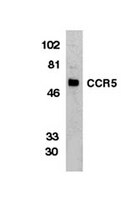Identification of a major co-receptor for primary isolates of HIV-1.
Deng, H, et al.
Nature, 381: 661-6 (1996)
1996
Show Abstract
Entry of HIV-1 into target cells requires cell-surface CD4 and additional host cell cofactors. A cofactor required for infection with virus adapted for growth in transformed T-cell lines was recently identified and named fusin. However, fusin does not promote entry of macrophage-tropic viruses, which are believed to be the key pathogenic strains in vivo. The principal cofactor for entry mediated by the envelope glycoproteins of primary macrophage-tropic strains of HIV-1 is CC-CKR-5, a receptor for the beta-chemokines RANTES, MIP-1alpha and MIP-1beta. | 8649511
 |
HIV-1 entry into CD4+ cells is mediated by the chemokine receptor CC-CKR-5.
Dragic, T, et al.
Nature, 381: 667-73 (1996)
1996
Show Abstract
The beta-chemokines MIP-1alpha, MIP-1beta and RANTES inhibit infection of CD4+ T cells by primary, non-syncytium-inducing (NSI) HIV-1 strains at the virus entry stage, and also block env-mediated cell-cell membrane fusion. CD4+ T cells from some HIV-1-exposed uninfected individuals cannot fuse with NSI HIV-1 strains and secrete high levels of beta-chemokines. Expression of the beta-chemokine receptor CC-CKR-5 in CD4+, non-permissive human and non-human cells renders them susceptible to infection by NSI strains, and allows env-mediated membrane fusion. CC-CKR-5 is a second receptor for NSI primary viruses. | 8649512
 |











